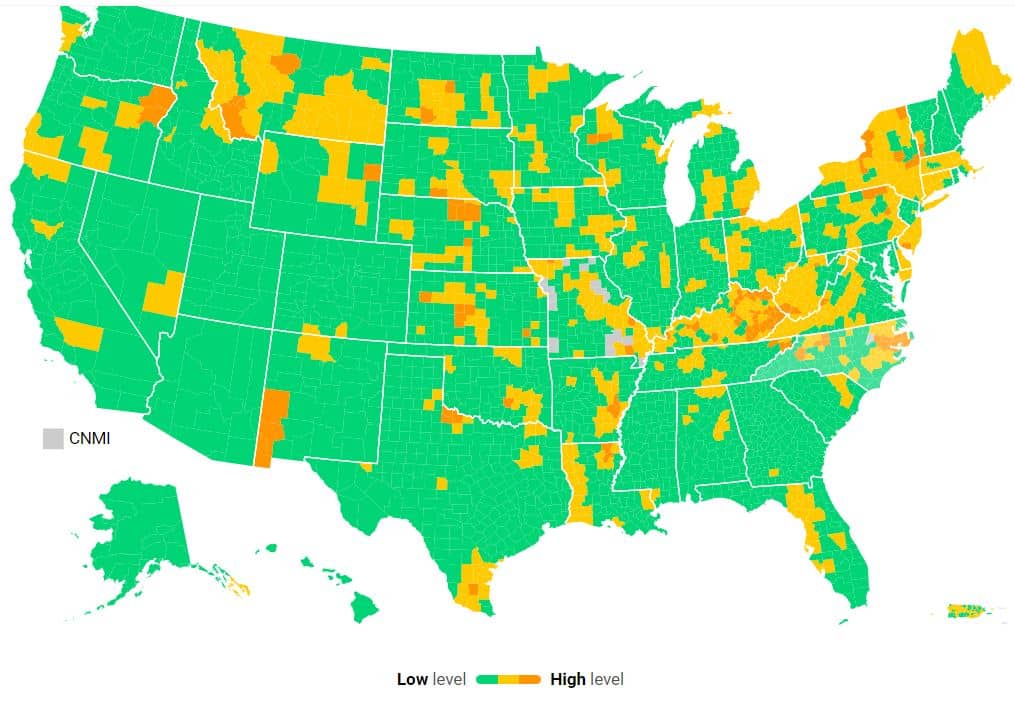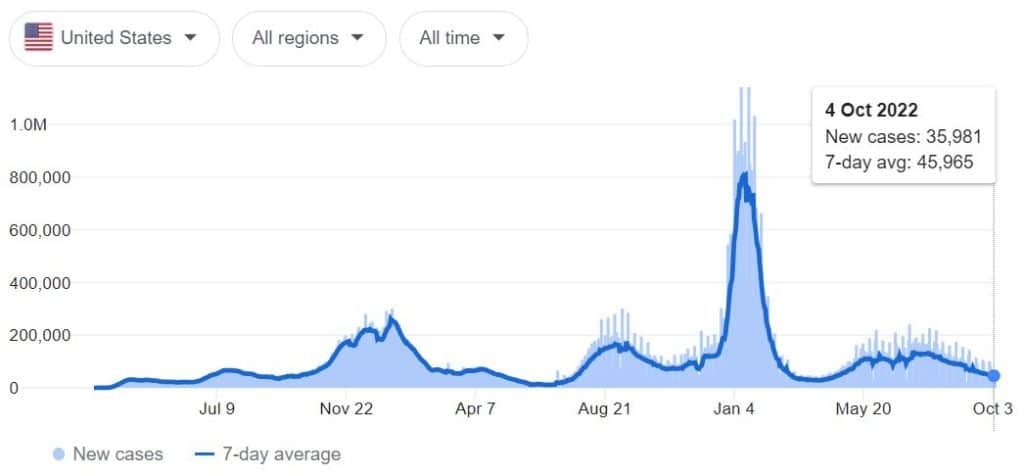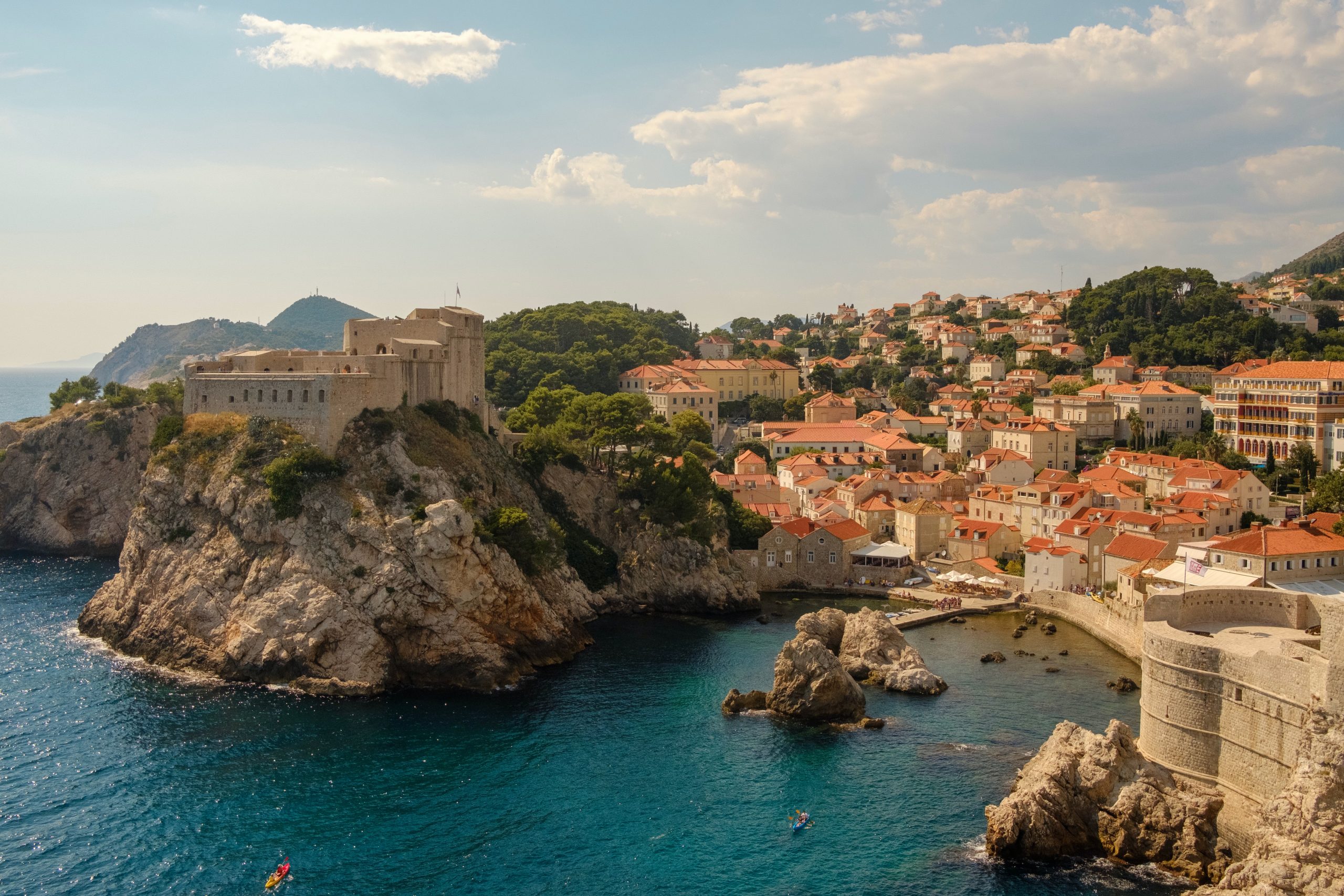US extends vaccine requirement for non-US travelers until January 8
The U.S. is open to tourists from all countries without testing requirement but vaccination is still required for all non-US citizens/residents.
US Reopening Tourism – LATEST UPDATES
November 10: TSA extended the vaccine mandate for non-US visitors
On November 7, the U.S. extended vaccine mandate for travelers until January 8. All non-US visitors still need to show a proof of the full vaccination against Covid-19. (Source: precisionvaccinations.com)
How can unvaccinated travel to the U.S.?
The only way unvaccinated travelers can visit the U.S. is to meet one of the exceptions. You can find all the details about exceptions on the C.D.C website.
Exceptions:
- Persons on diplomatic or official foreign government travel
- Persons with documented medical contraindications to receiving a COVID-19 vaccine
- Children under 18 years of age
- Persons issued a humanitarian or emergency exception
- Sea crew members traveling with to a C-1 and D nonimmigrant visa
- Persons with valid visas [excluding B-1 (business) or B-2 (tourism) visas] who are citizens of a foreign country with limited COVID-19 vaccine availability (See list for updates effective June 28, 2022)
- Members of the U.S. Armed Forces or their spouses or children (under 18 years of age)
- Persons whose entry would be in the national interest, as determined by the Secretary of State, Secretary of Transportation, or Secretary of Homeland Security (or their designees)
U.S. Reopening FAQs
Yes, U.S. requires proof of a Covid vaccine for land border crossinngs until at least January 8.
No, the testing required to enter the U.S. was dropped in June 2022 for all travelers entering.
Yes, the U.S. is fully open for regular tourism but the Covid-19 vaccine is still required.
The United States is still requiring Covid vaccine from non-US travelers and TSA has recently extended the mandate until at least January 8.
Even tho Covid restrictions and requirements are slowly losing importance around the world, there are more than 100 countries that still require Covid vaccines or tests for travel, and the U.S. is one of them.
November 2: Puerto Rico Officials scrap COVID-19-related domestic restrictions as of Oct. 31
Puerto Rican officials just lifted the island’s COVID-19-related domestic regulations as of Oct. 31. Facemasks are no longer necessary for attendees at events with more than 1,000 participants. Additionally, event goers are no longer needed to show proof of vaccination or a negative COVID-19 test result upon admittance.
Travelers must continue to adhere to the federal regulations for travel from countries other than the United States and its territories. Nonresident foreign nationals aged 18 and up must be properly vaccinated before flying into Puerto Rico. Vaccination is not required for children under the age of 18, and it is not required for air travel from the mainland United States.
October – The United States, the last North American country requesting proof of vaccination
The United States is officially the last North American country to prevent unvaccinated travelers from entering the country.
As of today, visitors to the United States must present proof of a COVI-19 vaccination certificate to be allowed entry.
Over the past two years, the U.S. has banned travelers from the European Schengen area, the United Kingdom, South Africa, and Brazil from entering the country at various times.
But while it was once supported by its best allies, notably Canada, it now stands alone in its quest for Covid security.
June – US Lifts Covid-19 Testing for International Travelers
Travelers to the United States are no longer required to submit a negative Covid 19 test taken within one day prior to departure.
The Centers for Disease Control and Prevention stated on Friday that this requirement would be removed beginning early Sunday morning. The health service stated that it will continue to monitor the pandemic’s progress and reevaluate the need for testing if the situation changes.
“This step is possible because of the progress we’ve made in our fight against COVID-19,” said the U.S. Health Secretary Xavier Becerra.
How safe is it to travel to the States at the moment?
According to America’s COVID Warning System, the country is overcoming the 4th wave of coronavirus infections.

COVID-19 cases in the U.S.

As of October 5, the U.S. has recorded 98,308,956 cases and 1,085,366 the highest death toll in the world.
Some of the current carrier flying from Europe to the U.S.
- Lufthansa United
- Air Europa
- Royal Air Maroc
- Air France
- Alitalia, Delta Operated by Alitalia CityLiner
- Delta
- KLM, Delta Virgin Atlantic
- Lufthansa, Air Canada 0perated by Air Canada Express – Sky Regional
- Lufthansa, Air Canada operated by Air Canada Express – Jazz
- Lufthansa, United operated by Mesa Airlines DBA United Express
- Tap Air Portugal
- Turkish Airlines
- Virgin Atlantic
US reopening borders for tourism: Update Archives
September – US still requires Covid vaccine from non-US citizens
As of September 19, proof of Covid vaccination is still required for entry into the United States for all non-US citizens. There is no recent update from the government on when they are planning to drop this requirement.
February 18 – The CDC considers lifting indoor mask-wearing mandate across the US
The Centers for Disease Control and Prevention (CDC) director may recommend the US to lift the need to wear face coverings in indoor settings, said CDC Head Dr. Rochelle Walensky during a White House briefing.
“We want to give people a break from things like mask wearing when these metrics are better, and then have the ability to reach for them again should things worsen.”
The CDC will review the number of severe cases and hospital capacity rather before making a final decision.
Also read: More US States Lifting Mask Mandates as COVID-19 Drops
January 15 – The US issues a “Do-not-travel” notice against Canada and Singapore
The CDC has issued the highest travel health advisory to Canada, Singapore and Curaçao due to the high incidence in COVID-19 cases in the previous week.
The CDC currently lists about 80 destinations throughout the world as Level Four.
Canadian health officials forecast the Omicron wave peak at 170,000 cases a day this month, with 2,000 hospitalizations also per day.
The CDC will revisit this travel advice on Monday.
December 22 – US considers lifting travel ban on Southern African countries
The US is reportedly considering lifting its ban on Southern African countries over the next few days.
According to the government, “we’re letting in people from other countries that have as much or more infection than the Southern African countries.”
“We likely are going to pull back on that pretty soon because we have enough infection in our own country,” said Dr. Fauci at the National Press Club.
In less than three weeks, the Omicron variant already accounts for over 73% of the new infections in the U.S. said the CDC on Monday.
December 4 – The US government tightens travel restrictions for all travelers
All international arrivals are now required to present a negative COVID-19 test taken within 1 day of departure.
“Our doctors believe tightening testing requirements for pre-departure will help catch more cases, potential cases of people who may be positive and inside the country,” a White House official said.
Also, domestic travelers using all types of public transportation such as trains, cruise ships or domestic flights will have to wear a face mask at all times or face fines of up to USD 3,000.
November 28 – The U.S. to ban all travel from South Africa and other 7 countries from Monday
The U.S. will ban travel from South Africa and other seven countries starting Monday as a new heavily mutated coronavirus variant emerges, announced White House officials on Friday.
Other countries included in the restriction are Botswana, Zimbabwe, Namibia, Lesotho, Eswatini, Mozambique and Malawi.
National and residents are allowed to come back.
“As we move forward,” said the President in a statement, “we will continue to be guided by what the science and my medical team advises.”
November 21 – The U.S. makes booster shots available to all people 18 and above
With an increasing number of countries requiring passengers to provide proof of booster shots to give them access to a number of tourist venues, the U.S.’s move to make booster doses available for most citizens brings relief for international travelers.
“Based on the compelling evidence, all adults over 18 should now have equitable access to a COVID-19 booster dose,” says the CDC.
Despite the fact that more than 195 million Americans are fully vaccinated, Covid cases are on the rise in some locations as vaccine effectiveness declines over time.
The Pfizer booster dose was found to be 95 percent effective in a clinical trial involving 10,000 people aged 16 and up.
November 13 – Travelers experiencing long wait times at U.S. airports
Following the reopening on Nov. 8, large numbers of overseas travelers have begun to arrive in American airports.
Although this is wonderful news for families and the tourism sector, 21 months of closure did not seem to be enough time for American airports to prepare for such a large influx of passengers all at once.
Thousands of travelers have complained about having to wait over two hours to get through customs. Things are expected to worsen as the Christmas holidays approach.
“The expectation is that we could see wait times of up to eight hours,” said Sherry Stein, the leader (SITA).
November 5 – The U.S. to welcome EU travelers as soon as ports of entry open on Nov. 8
Beginning Monday, the United States will drop entrance restrictions for vaccinated EU and Asian travelers, putting an end to historic restrictions that have kept the country partially isolated from the rest of the world for almost 21 months.
According to US Customs and Border Protection (CBP), the U.S. will reopen its air and land borders as soon as ports of entry start operations on Nov. 8
That means that border crossings that are open 24 hours a day will accept international travelers from midnight, while the rest will open during regular business hours.
October 15 – U.S. Government announces the reopening date for the European Union
White House has confirmed the reopening date for international tourism, current travel curbs will be lifted on November 8. Both land and air borders will reopen to fully vaccinated travelers.
Non-vaccinated air travelers will be also able to enter but they will need to show proof of a negative Covid-19 test.
The ban on non-vaccinated travelers will still remain in place on the Mexican and Canadian land borders.
October 20 – The U.S. is set to reopen land borders with Canada and Mexico in “early November”
The U.S. land borders, which have been shut down since March 2020, will reopen to Canadian and Mexican visitors at some point in November as long as they can prove they are fully vaccinated.
“We are pleased to be taking steps to resume regular travel in a safe and sustainable manner,” Homeland Security Secretary said in a statement.
Essential travelers such as truck commercial drivers, students, and other essential personnel will have until January to present their vaccine certificates.
October 10 – U.S. Reveals the vaccines it will accept for EU travelers
There was a lot of uncertainty over which brand of vaccines the US would accept as a valid entry requirement for EU travelers, once it open its borders.
The U.S. Centers for Disease Control and Prevention (CDC) has revealed the country will accept the following:
- Moderna
- Pfizer/BioNTech
- Janssen (Johnson & Johnson)
- AstraZeneca, including Covishield
- Sinopharm (Beijing)
- Sinovac
The CDC also informed that more information will be released as soon as the travel protocols are completed.
The reopening date has not been announced yet.
October 2 – US, Canada, UK, and other G7 leaders met to discuss the future of international travel
Transport and health ministers of Canada, Germany, the U.K, the U.S, Japan, Italy, and France virtually met to discuss the future of international travel on Thursday.
Among other things, the U.S. committed to a number of principles “for a safe and sustainable reopening of travel.” These include trusting scientific evidence, accepting both digital and non-digital test and vaccine passports, protecting users’ private data, and supporting cleaner technologies for land, air, and maritime transport.
Sept. 24 – The U.S. lifts the ban on European Travel but reopening date remains unknown
This week, the U.S. announced that its long ban on European travel will end in “early November”. But so far, they haven’t provided an exact reopening date yet.
The head of the White House’s COVID-19 Response Team, Jeff Zients, said that all travelers must be fully vaccinated, no exceptions.
The CDC will order commercial airlines to collect information from U.S.-bound visitors including their phone number and email address to act as a “public health surveillance system.”
More information about the date and the requirements is expected to be revealed over the next few weeks.
September 16 – The U.S. works on a “new system for international travel” aiming to reopen borders
White House coronavirus response coordinator Jeff Zients said on Wednesday the country is working on a “new system for international travel” that will include contract tracing for international visitors when the country lifts its travel ban.
The government aims to replace the current restrictions with a “safer, stronger, and sustainable” system.
The official did not reveal when the new system will be put into motion or the metrics it will use.
September 21 – The U.S. to reopen for vaccinated EU and other travelers in November, says government
Jeff Zients, the White House Coronavirus Response Coordinator, announced that the U.S. will reopen to visitors from the European Union in “early November.”
Additionally, fully vaccinated travelers from other 33 countries including China, India and Brazil will also be allowed to come back.
“We will move to this much stricter global system, so we will have a consistent approach across all countries,” Zients said.
Visitors will need to present proof of vaccination and a negative Covid-19 test.
September 10 – Nine EU countries have reimposed entry restrictions for American travelers in the last 10 days
On August 31, the European Council recommended removing the U.S. from the “save travel list.” Since then, 11 European countries have taken a stand on the U.S. situation.
As of today, Denmark, Netherlands, Spain, Italy, Germany, Czech Republic and France have enforced additional entry restrictions for Americans.
Netherlands, Spain, Czech Republic and France not only increased their restrictions but also completely barred the unvaccinated.
Sweden and Bulgaria have indefinitely closed their borders to all U.S. arrivals. Croatia, Portugal and Ireland will remain open.
August 31 – U.S. Updates Travel Advisory For Canada, Puerto Rico and Other Countries
Seven countries were moved up to Level 4 travel warning since they surpassed the limit of 500 new cases per 100,000 population over the last 28 days.
The affected countries this time were Switzerland, Saint Lucia, North Macedonia, Laos and Estonia due to their COVID-19 reports; and Oman and Azerbaijan because of raising concerns about terrorism.
Additionally, other 12 countries were moved up or down to the Level 3 travel advisory (high level of COVID).
Some of them because of their improvements in the fight against the pandemic, and some others like Canada and Germany because their efforts are not producing the expected results.
August 19 – U.S. officials and border mayors demand the White House to reopen international borders
A number of U.S. officials and border mayors are joining forces to request the White House to lift the travel restriction that has been in place for 18 months severely affecting their local economies.
A few weeks ago, Washington announced it will maintain restrictions on multiple countries and territories including the EU and China for the time being.
“The ultimate goal is to look for easing of restrictions on nonessential travel,” as well as the “specifics on what we can, need or must do to achieve that.” said San Diego Mayor Todd Gloria.
The government has not replied yet.
August 5 – the US works on a plan to request all international travelers to be fully vaccinated
The U.S. is reportedly putting in place a new system requiring all international arrivals to be fully vaccinated so they can be allowed to travel into the country, a White House official told Reuters.
“With limited exceptions (…) all foreign nationals traveling to the United States (from all countries) need to be fully vaccinated,” said the official.
He also added that “working groups” are getting ready for “when the time is right to transition to this new system.” However, the date when this plan will be set into motion was not released.
August 5 – the US works on a plan to request all international travelers to be fully vaccinated
The U.S. is reportedly putting in place a new system requiring all international arrivals to be fully vaccinated so they can be allowed to travel into the country, a White House official told Reuters.
“With limited exceptions (…) all foreign nationals traveling to the United States (from all countries) need to be fully vaccinated,” said the official.
He also added that “working groups” are getting ready for “when the time is right to transition to this new system.” However, the date when this plan will be set into motion was not released.
July 30 – Fully vaccinated Americans will be able to resume travel with the U.K. on August 2, but U.S. remains closed due to a delta variant and a surge in cases
While the U.S. continues to be closed for half of the world due to a surge in Covid cases, more countries have been adding it to the list of allowed visitors.
Effective August 2, double-vaccinated Americans and residents will be allowed to travel to the U.K. without quarantine.
There is a catch. Americans should’ve been vaccinated in the U.S. or in one EU country.
Although these travelers no longer need to quarantine, they will still be required to submit a negative PCR COVID-19 test before boarding and take another one on the second day of their stay in England.
This scheme does not apply to Scotland, Wales, and Northern Ireland for now.
July 16 – The U.S. borders will not reopen for EU or other travelers for the time being
“It defies logic. It defies science. It defies fact,” Democratic Representative of New York, Brian Higgins told CNN, regarding the lack of transparency about the U.S. international borders reopening.
Another White official said that European Union, United Kingdom, Canadian and Mexican task groups have met with their American counterparts to discuss the aspects that would allow them to safely reopen the country.
However, another White House official told Reuters that “the Biden Administration is not in a rush to lift travel restrictions soon.”
July 9 – The U.S. can’t put a date on the international borders reopening, says government
The U.S. is unable to put a date on international travel reopening according to a White House official who spoke to Reuters on July 7.
“There are further discussions to be had before we can announce any next steps on travel reopening with any country,” said the official.
This is the second time in less than 2 weeks that a Biden’s administration official speaks about the impossibility to determine when the country will reopen for tourism.
On June 25, the US Secretary of State Antony J. Blinken also told reporters they could not give an approximate date and that everything will “have to be guided by the science and by medical expertise.”
As of today, Schengen area residents who are not American citizens are only allowed if traveling under the National Interest Exception (NIE).
June 25 – U.S. to resume international tourism after September 6, said U.S. Commerce Secretary
The long-awaited reopening to EU tourists may be about to be over.
U.S. Secretary of Commerce Gina Raimondo has stated the country is actively seeking to open travel bubbles with key partners so they can resume international travel soon.
Although not a specific date was announced, Raimondo mentioned Labor Day, which is celebrated on September 6, as the potential date for free foreign travel.
“I’m hopeful that post-Labor Day we will see a nice uptick in business travel and international travel” […] “I can promise that getting business travel and international travel going again is a top priority,” said Raimondo.
June 9 – U.S. to form task groups with Canada, Mexico, the EU and the U.K. to create a strategy to safely reopen borders soon
Multiple EU countries expected President Joe Biden’s announcement about the U.S. border reopening during his visit to the U.K. for the very first G7 summit of his administration.
But instead, the White house has issued a statement informing the country will not reopen just yet.
“While we are not reopening travel today, we hope that these expert working groups will help us use our collective expertise to chart a path forward, with a goal of reopening international travel with our key partners when it is determined that it is safe to do so,” reads the statement.
For now, the U.S. will form task groups with Canada, Mexico, the EU and the U.K to find the safest way to start international travel.
May 24 – The U.S. has not decided yet whether they will reopen to Europeans or not this summer
On May 19, all E.U. members agreed to welcome back Americans from June. E.U. countries can still enforce extra testing or quarantine requirements, but in principle, all vaccinated Americans will be allowed to visit Europe for tourism again.
Unfortunately, on the other side of the Atlantic things seem to be different. Biden administration has been reportedly holding meetings and contacting tourism industry leaders but reopening decisions have not been made yet.
Last week, White House spokesman Jen Psaki stated that no changes on current travel restrictions have been planned thus far when asked if the U.S. would allow vaccinated travelers to visit America Again. (Source: Reuters)
Canadians can enter Europe starting July 1. Here’s what you need to know

The announcement, which was foreshadowed earlier last week by European diplomats, comes as daily infections of the novel coronavirus in Canada continue to see a general decline.
The ease in travel restrictions applies to countries such as Australia, Japan, New Zealand and South Korea. The United States, however, joined other large countries like Brazil, Russia and India that didn’t make the cut due to a large number of COVID-19 infections.

The ease in restrictions now presents a way for Canadians to take a vacation or see their loved ones across the Atlantic Ocean.
Here’s what Canadians should know before deciding whether to travel.
Can Canadians leave and enter the country freely?
Despite there being a strict advisory to “avoid all non-essential travel” outside of the country, Canadians are essentially allowed to come and go as they wish.
However, all travellers will have to undergo a mandatory 14-day quarantine upon return.

The federal government’s advisory also maintains that “airspace closures and movement restrictions can occur without warning,” which could prevent Canadians from returning at any time.
“The Government of Canada is not planning additional facilitated flights to bring Canadians home during the COVID-19 pandemic,” the advisory states.
A statement from Global Affairs Canada has since said that travelling during the pandemic still remains the “responsibility of the individual.”
“Today’s announcement is only a recommendation from the European Council to the EU Member States,” said a GAC spokesperson. “As such, Canadians seeking to travel abroad are strongly advised to contact the nearest diplomatic office of the relevant country to check on restrictions and requirements.”
What are the rules after landing in Europe?
According to a press release issued by the EU on Tuesday, the decision to ease travel restrictions only comes as a recommendation, and is “not a legally binding instrument.”
This means that member states still get the final say on their own travel restrictions, but the 31 European countries have all agreed to begin lifting said restrictions starting Wednesday.
It’s recommended to check the travel restrictions first of any European country, as quarantine measures vary.
The list of countries allowed to enter the EU will also be updated every 14 days, with some being added or taken off depending on how well they keep their COVID-19 outbreaks under control.




What happens if a Canadian contracts COVID-19 abroad?
Similar to the travel rules in each European country, public health and treatment for the coronavirus will differ.
According to Canada’s travel and COVID-19 guideline, Canadians should avoid contact with others and follow local public health information on how to seek help should they contract the disease.
Canada’s guideline also recommends checking with insurance providers or making sure that you would be covered medically in the event you need treatment outside the country.

Canadians with coronavirus symptoms can still return to Canada by land, rail or sea but cannot fly back via air.
Canadians are also urged to contact Canada’s local consular office in the event they need help abroad.
To date, more than 104,000 Canadians have been diagnosed with the novel coronavirus and a further 8,591 have died.
Worldwide, more than 10.3 million people have contracted the disease and over 507,000 have died, according to a running tally from John Hopkins University.

Canada extends its own travel ban
Canada on Tuesday also extended its ban on all non-essential international travellers who aren’t Canadian citizens, permanent residents or U.S. residents.
“To protect Canadians and to ease the potential burden non-essential travellers could place on our health care system and its frontline workers, the CBSA has implemented travel restrictions across all ports of entry in all modes of transportation – land, sea, air and rail. All travel of an optional or discretionary nature, including tourism and recreation, is covered by these measures,” read a statement from a Canadian Border Services Agency spokesperson.

“This order is an extension of the previous order and is in effect for ALL foreign nationals. There is no separate provision for EU travellers.”
The extension of the ban means that Canadians would technically be allowed to travel to the EU, whereas European residents would not be able to travel to Canada unless deemed essential.
A separate order banning all non-essential travel between Canada and the United States was also extended earlier this month until at least July 21.
Is it safe to fly on an airplane?
In a previous story with Global News, infection control epidemiologist Colin Furness advised against boarding a plane over how easily the virus could spread in close proximity to those on board.

The comment comes as Canadian airlines Air Canada and WestJet announced an ease of physical distancing rules on board their planes by freeing up their middle seats.
“I don’t want any Canadian taking that kind of risk,” said Furness.
— with files from the Associated Press, Andrew Russell and Hannah Jackson
Canadians Are On The List Of 15 Nationalities Allowed To Enter The European Union In July

We are at Flytrippers take our position of influence as travel experts very seriously. So we still don’t recommend traveling right now… but we also are very optimistic that we’ll be able to do so extremely soon (finally).
We’ll tell you more about that very soon: what to consider, travel insurance tips, how to travel safely, a map of all the countries that you are allowed to go to, etc. (sign up for our free newsletter to get it first).
But let’s look at today’s EU announcement.
The EU reopening
The only travel restrictions that exist are entry restrictions imposed by other countries (a reminder of those basics can be found below).
Some countries have already reopened to Canadians. But Europe is a very popular summer destination so this is major news.
The European Union has established a list of 15 nationalities that will be allowed in as soon as today (external borders are supposed to reopen on July 1st). Canada is on the list, while the US is not (unsurprisingly). They have chosen countries that were seeing declines in coronavirus cases, similar to the EU itself.
The coronavirus pandemic is well under control in Europe, and frankly, the reasons we are still holding out on recommending travel have nothing to do with the coronavirus risk itself, as we’ll explain in greater detail in our article about the travel decision process.
It’s that there are still some complexities. Like the fact that the border control is not a EU role…
The major caveat
The fact we’re on the list is great news (especially since they aren’t requesting reciprocity, as our own border might not reopen to non-Canadians).
But you shouldn’t just assume you are allowed to go anywhere in Europe.
The biggest issue with the EU announcement is that it is just a recommendation and it is not a binding list. That is the quirk with the unique border situation in Europe and in the European Union (and even in the Schengen area; detailed article to come for those who are intellectually curious and love to learn).
If you’re familiar with how the EU political union works, the fact of the matter is that every member state can decide who they want to let in.
Border control is decided by individual countries. Every country makes its own rules, not the EU. This announcement does not change anything about that. These are guidelines.
The countries have agreed (a majority vote, not a unanimous vote) on this common list of allowed nationalities, so in theory, almost all European countries will use this same list. But they are not obligated to do so, and some could definitely decide to let in different nationalities (or not let in).
This will complicate internal European border controls (since there are normally none), but it’s definitely a possibility (they’ve all acted separately since March already).
In short, with this list of allowed nationalities, the EU is trying to coordinate and unify travel restrictions to make things simpler. And it could very well turn out to be what every country in Europe decides to do, but it is not guaranteed.
Our upcoming map of entry restrictions for Canadians will show you clearly whether or not each country decides to allow Canadians in.
Other conditions
Another thing to keep in mind is that just because the country lets Canadians in doesn’t mean there aren’t conditions.
While most European countries are planning to reopen without quarantine on arrival or testing required, other European countries might want to be more careful and could impose conditions, despite the fact that their borders are open to Canadians and despite the fact that neighboring countries won’t be imposing any conditions whatsoever.
Our color-coded map will show those distinctions very clearly too.
Good planning is always the key to better (and cheaper) trips, but it’s now more true than ever.
One last warning
Before you think that once you’re allowed in, you’re allowed in until the end of time… (no joke, we actually received questions from travelers asking us if they will be allowed into X country in 2021… unfortunately, no one can predict for next month, so no one can predict for next year).
You need to understand that every country can change its rules at any time. Even the EU’s list will be re-evaluated every 2 weeks, so just as we are allowed in now, we could be banned in just 2 weeks (unlikely, but you get the point: it’s not set in stone).
I don’t want to discourage you from traveling to Europe this summer, quite the contrary (I’m most likely going myself).
But you need to understand the next point, it’s the most important one.
The most important thing to understand
In short, the most important thing Canadian travelers need to understand is that things are changing very quickly and are very fluid.
As much as I’d love to say that you can definitely travel to a specific European country in July, it would be irresponsible (just as irresponsible as saying that you definitely can’t travel to a specific European country in July). The fact is, we just don’t know yet (either way).
Countries are just starting to reopen, and we’re awaiting the impact (if any) and we’re especially awaiting the finalization of every country’s plans to make sure that yes, you really are allowed in (and without conditions, hopefully).
And the main reason why Flytrippers is waiting a bit before recommending to travel is to confirm that countries who’ve reopened in the second half of June are not changing their minds and that things are looking good. So that those who reopen in July can really stay open.
That said, even when we do recommend traveling, sadly the reality for this summer (because it is all so new, after months of lockdown) is that you will have to book closer to departure and be comfortable with being flexible to change your destination at the last minute (being easygoing is always a great asset for a traveler anyway).
It’s a shame, but that’s the truth. We’d be doing you a disservice by pretending otherwise. Planning travel will be a bit more complicated, but still: that doesn’t mean you should rule out traveling this summer. Not at all.
I myself have flights to Europe booked on August 3rd, and I’m over 90% sure I’m going to be on that plane, barring major changes in the next 4 weeks. But will I stay in Turkey, where I am landing? Absolutely unclear; I will decide a few days before, that’s it. I’ll simply go where it’s safer and where it’s open. There are over 40 countries in Europe and internal flights are almost always under $100. I’m not too stressed out about that.
Learning to not stress out and to go with the flow will be very useful for all your future trips.
And complicated travel sure beats being stuck traveling nearby, at least in my personal opinion.
Travel restrictions basics (reminder)
You can skip to the last section if you already understand, but so many people struggle with this, so it’s worth repeating.
If all of this is a bit complicated, the good news is that one thing is really simple to understand: there is only ONE THING that determines whether you CAN travel or not.
Just one. It literally cannot be any simpler:
- The only thing that determines if you CAN travel is whether the country you are traveling to allows Canadians to enter.
You are allowed to leave Canada (and have always been), you are allowed to re-enter Canada as a Canadian (and have always been), and international flights are allowed to enter Canada (and have always been). We’ve explained these basics in our post about the 3 myths regarding travel restrictions (also called entry restrictions, border restrictions, travel bans, and border closures).
That doesn’t mean you SHOULD travel; that’s a whole other topic. But many seem to confuse personal decisions with actual restrictions, so it’s important to understand that there is only one actual restriction: whether the country you are going to lets you in.
Should you travel?
Now that’s the more complex question, the one that will depend on your own personal situation. We’ll cover it in great detail as we approach the moment when we’ll recommend traveling, in other words: probably very soon.
One of the major issues is travel insurance. We’ve found an insurer that covers everything except COVID-19 (detailed post to come), which is great news for those who are at a low risk of hospitalization if infected by the coronavirus.
That said, maybe the fact that Europe is reopening will lead Canada to finally lift the travel advisory, at least for safe countries (the advisory doesn’t keep you from traveling at all—remember, there is just ONE thing that does that—but it does have an impact on travel insurance).
It’s not impossible at all: Europe has many of the world’s developed countries and they are reopening to travel and recommending travel… so we can hope. If the travel advisory is lifted, then even COVID-19 could be covered by many insurers.
Hoewever, as Canada has extended the 14-day quarantine requirement (when returning) until August 31st, it seems unlikely that the advisory will be lifted. So that’s another aspect of your decision, since not everyone is lucky enough to work from home.
There are obviously many other factors to consider. But we’re even more optimistic than before. Don’t miss our important guide with everything you need to know.
Source https://www.travelinglifestyle.net/us-reopening-borders-to-tourism-who-can-enter/
Source https://globalnews.ca/news/7125185/coronavirus-european-union-entry-canada/
Source https://flytrippers.com/european-union-borders-reopening-canadians/